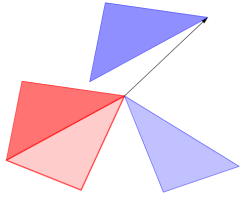eText Chapter 2 (DRAFT)
June 27, 2014
Professor Kellie Evans (kellie.m.evans@csun.edu)

Working Title: Geometric transformations (rotations, reflections, and translations) and advanced perspectives

Working Title: Geometric transformations (rotations, reflections, and translations) and advanced perspectives
This chapter will illustrate the new emphasis in the Common Core on geometric transformations. Ideas will be presented as in Chapter 1, starting from basic postulates and leading to important ideas such as congruence and similarity. This chapter will be crucial in illustrating how the transformation approach to congruence and similarity in the new standards differs from the old. Where possible, we will contrast the new approach with the approach prospective teachers are likely more familiar with (i.e. they way they learned these topics; this may occur in an appendix). All of the following Common Core standards will be covered and connections will be made to advanced topics such as group theory.
Geometry. Congruence (G.CO) Experiment with transformations in the
plane.
The first standard will have been covered in Chapter 1:
1. Know precise definitions of angle, circle, perpendicular line,
parallel line, and line segment, based on the undefined notions
of point, line, distance along a line, and distance around a circular arc.
2. Represent transformations in the plane using, e.g., transparencies
and geometry software; describe transformations as
functions that take points in the plane as inputs and give other points as
outputs. Compare transformations that preserve
distance and angle to those that do not (e.g., translation versus
horizontal stretch).
3. Given a rectangle, parallelogram, trapezoid, or regular polygon,
describe the rotations and reflections that carry it onto itself.
4. Develop definitions of rotations, reflections, and translations in
terms of angles, circles, perpendicular lines, parallel lines,
and line segments.
5. Given a geometric figure and a rotation, reflection, or
translation,
draw the transformed figure using, e.g., graph paper,
tracing paper, or geometry software. Specify a sequence of transformations
that will carry a given figure onto another.
Understand congruence in terms of rigid motions. [Build on rigid motions
as a familiar starting point for development of concept
of geometric proof.]
6. Use geometric descriptions of rigid motions to transform figures
and to
predict the effect of a given rigid motion on a given
figure; given two figures, use the definition of congruence in terms of
rigid motions to decide if they are congruent.
7. Use the definition of congruence in terms of rigid motions to show
that
two triangles are congruent if and only if correspond
ing pairs of sides and corresponding pairs of angles are congruent.
8. Explain how the criteria for triangle congruence (ASA, SAS, and
SSS)
follow from the definition of congruence in terms of
rigid motions.
As in the rest of the text, GeoGebra applets such as the following will be used to motivate and illustrate ideas.
Use the definition of congruence in terms of rigid motions to determine whether the parallelograms given in the following applet are congruent. That is, determine whether there is a sequence of "rigid motions" (translations, rotations, reflections) whose composite maps one parallelogram onto another so that they coincide (match exactly).
Use the definition of congruence in terms of rigid motions to determine which, if any, of the line segments given in the following applet are congruent.
Use the definition of congruence in terms of rigid motions to determine which, if any, of the angles given in the following applet are congruent.
Use the definition of congruence in terms of rigid motions to determine which, if any, of the triangles given in the following applet are congruent.
What do you notice about the experiment above?
What do you wonder?
Homework Assignment
| Chapter 2 |
Link
to Homework
|